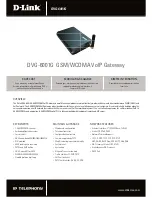
124
degrees of security and speed of negotiation:
Main Mode: Uses the automated Internet Key Exchange (IKE) setup; most
secure method with the highest level of security.
Aggressive Mode: Uses the automated Internet Key Exchange (IKE) setup;
mid-level security. Speed is faster than Main mode.
Manual Key: Standard level of security. It is the fastest of the three
methods.
Method: There are two methods of checking the authentication information, AH
(Authentication Header) and ESP (Encapsulating Security Payload). Use ESP for
greater security so that data will be encrypted and authenticated. AH data will be
authenticated but not encrypted.
Encryption Protocol: Select the encryption method from the pull-down menu.
There are several options: DES, 3DES, and AES (128, 192 and 256). 3DES and AES
are more powerful but increase latency.
DES: Stands for Data Encryption Standard. It uses a 56-bit encryption
method.
3DES: Stands for Triple Data Encryption Standard. It uses a 168-bit
encryption method.
AES: Stands for Advanced Encryption Standard. You can use 128, 192 or
256 bits as encryption method.
Authentication Protocol: Authentication establishes data integrity and ensures
it is not tampered with while in transit. There are two options: Message Digest 5
(MD5), and Secure Hash Algorithm (SHA1). While slower, SHA1 is more resistant to
brute-force attacks than MD5.
MD5: A one-way hashing algorithm that produces a 128
−
bit hash.
SHA1: A one-way hashing algorithm that produces a 160
−
bit hash.
Perfect Forward Secure: Choose whether to enable PFS using Diffie-Hellman
public-key cryptography to change encryption keys during the second phase of VPN
negotiation. This function will provide better security, but extends the VPN
negotiation time. Diffie-Hellman is a public-key cryptography protocol that allows
two parties to establish a shared secret over the Internet.
Pre-shared Key: This is for the Internet Key Exchange (IKE) protocol. IKE is
used to establish a shared security policy and authenticated keys for services (such
as IPSec) that require a key. Before any IPSec traffic can be passed, each router
must be able to verify the identity of its peer. This can be done by manually entering
the pre-shared key into both sides (router or hosts).
IKE Life Time: Allows you to specify the timer interval for renegotiation of the
IKE security association. The value is in seconds, eg. 28800 seconds = 8 hours.
Содержание BiGuard 30
Страница 1: ...BiGuard 30 iBusiness Security Gateway SMB User s Manual Version Release 5 00 FW 1 03...
Страница 46: ...46 2 Double click the Network icon The Network window displays a list of installed components...
Страница 48: ...48 c Select the manufacturer and model of your Ethernet adapter then click OK If you need TCP IP a Click Add...
Страница 51: ...51 2 In the Control Panel double click Network and choose the Configuration tab...
Страница 171: ...171 Main Aggressive mode peer ID is identifier string ISAKMP SA Established IPsec SA Established...
Страница 182: ...182 Step 4 From the same menu set the WAN2 DDNS settings Step 5 Click Save Config to save all changes to flash memory...
Страница 190: ...190 Step 4 Go to Configuration Advanced Dynamic DNS and input the dynamic DNS settings for WAN1 and WAN2 WAN1...
Страница 191: ...191 WAN 2 Step 5 Go to Configuration Virtual Server and set up a virtual server for both FTP and HTTP...
Страница 207: ...207 Step10 Input PPTP Server Address and press Next Step11 Please press Finish...
Страница 211: ...211 Step5 In another BiGuard as Client Go to Configuration WAN ISP Settings Step6 Click Apply and Save CONFIG...
















































